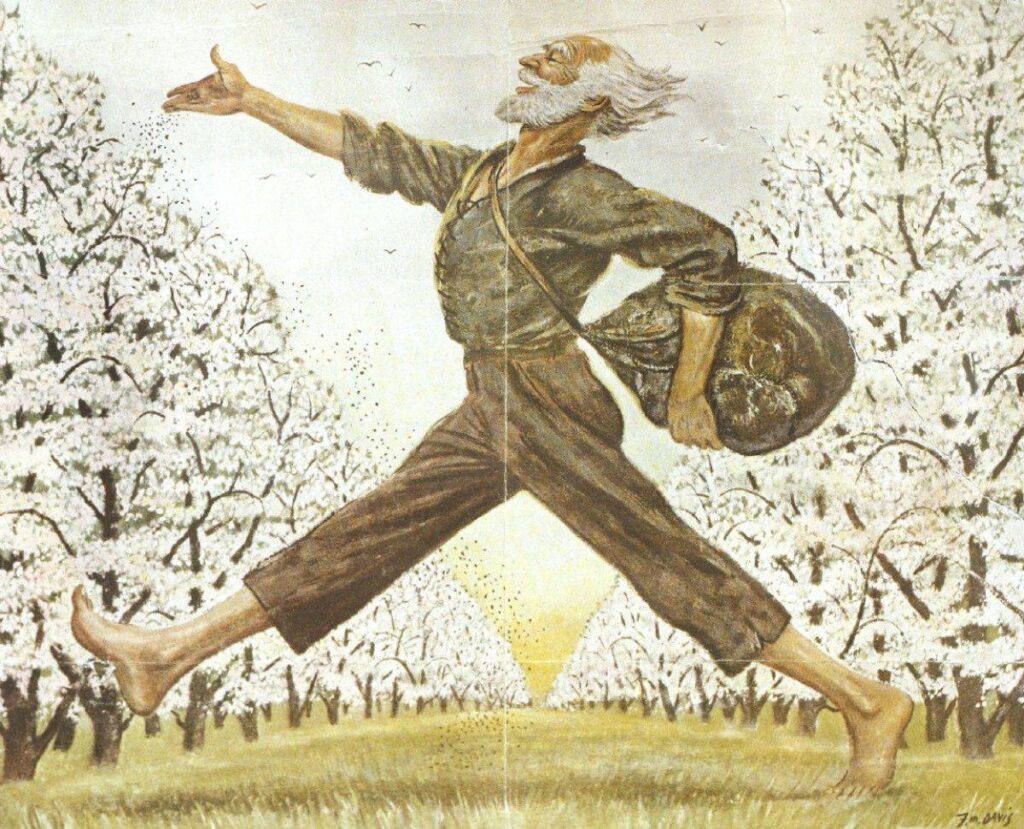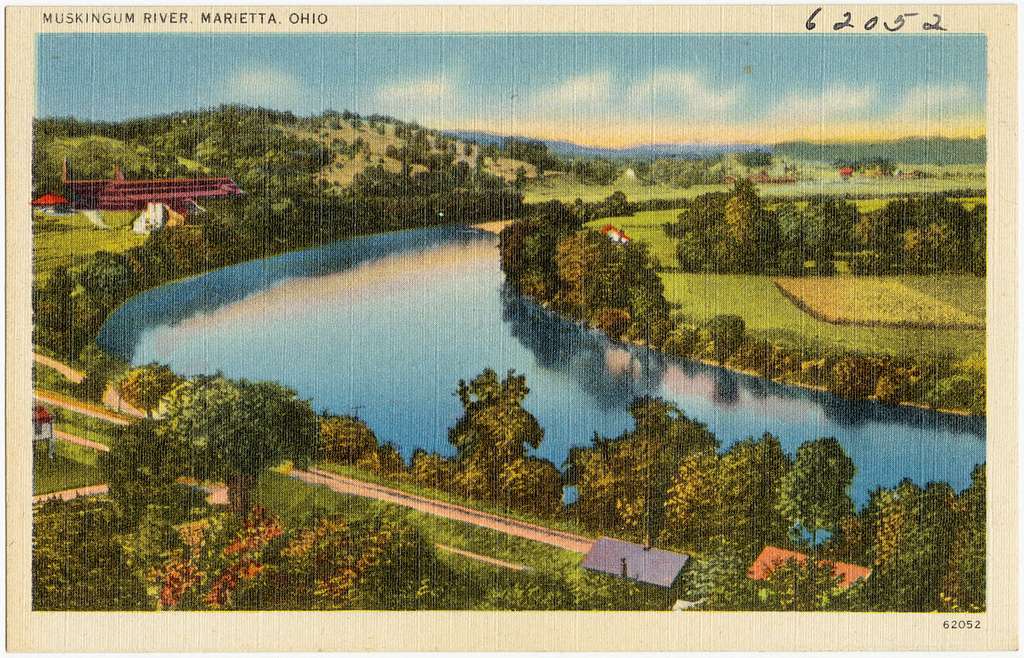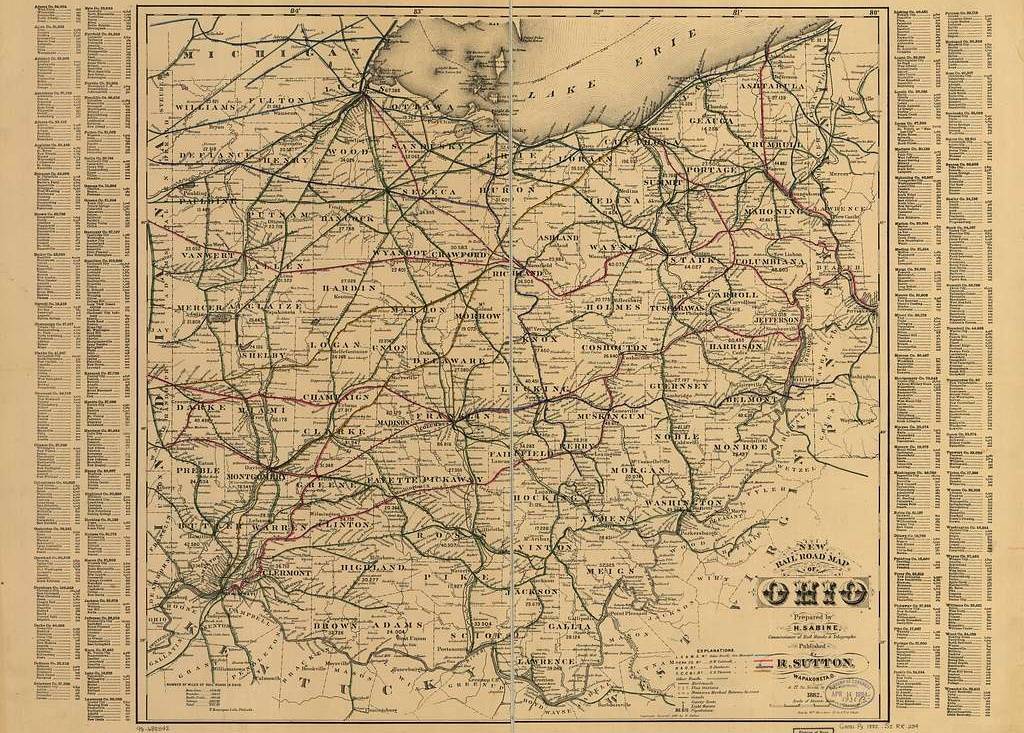Growing up, I swear I remember seeing the name Johnny Appleseed all over the place. Back in the days when my age was a single digit, I thought he was pretty cool, planting trees and doing … tree planting stuff, I guess.
Fast forward roughly twenty or so years and I was giving a talk in front of a couple hundred people. The nature of my presentation isn’t important, but what was important was that about a quarter of the way into it, I referenced Johnny Appleseed and looked out into the crowd and saw nothing but confused faces. I paused a moment, then asked if everyone remembered Johnny Appleseed? Everyone shook their heads. “Come on, Johnny Appleseed, kind of like Paul Bunyan but he planted trees instead of chopping them down?” Once again, every face in the room showed confusion.
“I swear you’ve heard of Paul Bunyan. There’s a huge statue of him in the movie Fargo?” (That movie had just come out.)
Being that I didn’t feel qualified to give a history lesson on a man I barely remembered as a kid, and since I felt the moment had already passed, I made an awkward transition into my next topic and the rest of the talk went just fine.
Later that day, I asked a few people if they remembered Johnny Appleseed and none of them said they had. The following week, I polled quite a few of my friends and once again, the name didn’t ring a bell. I was starting to think Johnny didn’t actually exist, maybe I was misremembering something from my childhood. Why not? Back then I thought that Santa and The Easter Bunny were real, too. So, maybe he was just a fictional story character I didn’t remember half as well as I thought I had.
At the big public library in Downtown, Denver, I discovered that several books had in fact been written about him, he lived from 1774 to 1845, and he did a bunch of cool things between those years. So then, how come I remembered him and nobody else did?
A teacher friend of mine gave me what was the most likely answer to that question: I was born and raised in Ohio. Johnny Appleseed was a historical figure in and around Ohio, Pennsylvania, Illinois and Indiana – so chances are he was referenced a lot more in those states as opposed to faraway states, like Colorado.
The Legend of Johnny Appleseed?
Johnny’s real name was John Chapman, born in Leominster, Massachusetts (which at the time was a British Colony). He was known for being a kind and generous man and was well-liked among his peers, if not a bit eccentric.
Johnny has been featured in just about every form of media throughout history, including countless television shows and children’s comics have featured a characterization of him (or based on him), including the Disney Short The Legend of Johnny Appleseed, which originally appeared in Melody Time, but would later appear in various other Disney-related anthologies. Disney also used the character in This is You Life, Donald Duck, The House of Mouse, and Cinderella II: Dreams Come True. Johnny has also appeared on postage stamps, in a musical Johnny Appleseed by Jill and Michael Gallina. There are also a number of places that host festivals dedicated to Johnny, have built statues in his honor, or formed museums around him.
The way that Appleseed appears in media is about as varied as you can get. In some, he is just an average fellow, typical of the time period, making his way in the world as the nation expanded westward. In others, he’s a religious figure, sent by God or Angels to plant apple trees and prove his worth or spread the gospels. Other stories focus on him as a more conservationist figure, spreading the ideas of conservatism while planting trees on his trek westward.
What all (or, at least the vast majority of) the stories have in common is that they depict the man traveling westward, first from Massachusettes into Ohio, then later into Indiana, planting trees along the way.
Like many historical tales, especially the ones told to children, but some “details” that have been reported as fact also do not stand up to historical scrutiny. Sometimes, these stories are exaggerated or have new details added to make them more interesting to Children. A good example is the legend of George Washington not being able to tell a lie – he chopped down that cherry tree. Not only is there no evidence this ever happened but many historians point to facts that completely go against this event ever taking place. Still – it’s a good story to tell the kiddos, right?
But, with Johnny Appleseed, there might be something else going on, too. Some details may have made their way into the legends in order to impugn his character, to make him seem like a fool, or to cover up aspects of himself or his story that went against what people wanted to hear.
In the Disney short, Johnny was depicted as a Christian missionary, spreading apple seeds with the word of God. (In fact, it was the first Disney cartoon to feature a Bible, and the second cartoon to feature religious themes.) This may have some small basis in truth, but Johnny’s main mission in life had little to do with religion, being a missionary, or spreading the word of God. He was known to be a somewhat religious man, although the church he was affiliated with, The Swedenborgian, was hardly considered a “Christian” church in that sense. In fact, many considered its teachings highly heretical.
In other stories, Johnny was featured as more of an idiotic character, most notably depicted as wearing a tin pot in lieu of a hat. Many of these stories featured somewhat pro-conservatism messages but were presented in a way that could easily be dismissed or laughed at. This is hardly the kind of thing one would do to promote such ideas.
Whenever facts like these are presented in any kind of historical sense, it makes it all the harder to get to the honest, historical truth.
The Real Johnny “Appleseed” Chapman
Historical records do indicate that Johnny was born in Leominster, Massachusetts on Johnny Appleseed Way, although I’m pretty sure the name of the street was changed later. (Otherwise, that would be a HUGE coincidence.) Today, a memorial plaque can be found there.
Johnny was the second child born to Nathaniel and Elizabeth Chapman. His father worked as a carpenter, and there is evidence that he fought in the American Revolution against the British. Johnny had an older sister, Elizabeth (named after their mother). In July 1776, tragedy would strike the family. Elizabeth gave birth to Johnny’s younger brother, Nathaniel Jr., and within weeks both had died.
Nobody is entirely certain when (why, or how) Johnny began traveling westward, we just know that he did.
In order to fully understand Johnny Chapman, we really ought to take a look at how he lived his life, and what kinds of things he believed in.
Some of the historical information we have of him comes from The New Church, based on the teachings of Emanuel Swedenborg (1688–1772). While some consider The New Church to be a Christian denomination, many others consider its teachings heretical. For example, while most Christian churches teach that salvation is acquired by a belief in (or the following of) the teachings of Jesus, along with dogmatic traditions, The New Church believed that salvation was achieved by the performing of good deeds and by treating your fellow man fairly and with love and respect.
In other words, instead of professing a belief in Jesus and doing things like tithing a percentage of your income to the church and following strict moral guidelines – all anyone needed to do to get to Heaven was to be a good person and to do good things.
Obviously, I am as far from an expert on The New Church as you can get, so don’t quote me on any of this. But, from what I’ve read, that seems about right.
This puts the traditional view of Johnny as a Christian Missionary in a whole new light. The New Church wasn’t about converting people to the Church or to any other form of Christianity, or any of the other things normally associated with missionary work. Therefore, calling Johnny a missionary is a bit misleading. Johnny did share his religious views with anyone who asked about them, but recruiting is an entirely different matter altogether.
This ideology might also play into one aspect of Johnny’s life story that is often overlooked – his interactions with the indigenous populations.
During this period of history, European settlers were starting to expand westward from the original colonies. The view of many settlers was that this land was now theirs and the native population needed to start heading west. Needless to say, this didn’t go over very well with the people who had been living on this land for a long time and history is pretty clear that it didn’t take long for things to get ugly – from both sides.
Johnny never got involved with any of the political interactions between the native population and the new American government. What he was able to do, however, was to sit down with one or both parties during a dispute and come up with solutions that would be good for everyone involved. He was likely guided by his beliefs in the teachings of Swedenborg, the idea that everyone should just do good in the world, and oftentimes his version of what was fair wasn’t the same as other early pioneers.
It is clear that Johnny did not believe in the American view of “this is our land now – you get out”. But, he was hardly in a position to do much about it, at least on a national level. But he could, and often did, speak with other pioneers and tribal leaders, trying to work out compromises and settle disputes.
Some historians do believe that this is why this aspect of Johnny’s life often went ignored (or was highly downplayed) in the history books. You can make a valid argument that Johnny believed that the way the new American government was treating the natives wasn’t right, or fair, which sounds un-American to a lot of folks.
When we ask why Johnny Appleseed started heading west in the first place, we’re probably overlooking the most obvious answer – That’s what a lot of people other people were doing at the time. America was expanding throughout the Ohio Country, and many people thought this newly acquired land was a great place to build a new life for themselves and their families.
The legends often depict Johnny Appleseed as constantly traveling west, often with magical apple tree seeds to plant wherever and whenever he could. In a general sense, he did travel westward, through Ohio and into Indiana, but this, too, is somewhat misleading. (Except for the magical seeds part – that’s … very wrong.)
It wasn’t as much of a westward pilgrimage as some like to make it sound. It was more likely that other people were traveling west, so he did, too.
When Johnny arrived in Ohio, he bought a parcel of land upon which he planted some apple trees (and likely some other vegetables, too). This was more of a nursery than an orchard. He spent some time cultivating his trees, perhaps helping nearby farmers with their trees and crops, then he’d purchase another plot of land some distance away and start again. Then he’d return to his first plot, work there some, then return to the second before buying a third. All along the way he would talk with the other pioneers, and the native people he encountered, helping them with their trees, too.
Perhaps, most of all, Johnny Appleseed was a naturist. Now, keep in mind that in Johnny’s day a “naturist” was one who liked being in nature, not really someone who likes to play volleyball without any clothing on. That being said, Johnny was usually spotted barefoot, so … maybe?
What Does All This Say About Johnny?
When I started to look at the historical Johnny Appleseed, I started to realize that most of what I knew about him was more myth and legend and less historical fact. But, that’s not to say that the real guy was any less interesting – just for different reasons.
Johnny Appleseed’s life was, for all intents and purposes, about spending time in nature, supporting the planet’s natural resources, and just being a good person. Honestly, I don’t see anything inherently wrong with that.
But, I can also see how some of Johnny’s beliefs can go against certain religious views. But, isn’t religious freedom what America is supposed to be about? You can believe what you want to … and I can believe what I want to … and who can say who is wrong and who is right? (Yeah, I know, a lot of people think they’re beliefs are the only valid ones, not much I can do about that.)
Dig Deeper…
- Johnny Appleseed – Wikipedia
- The Johnny Appleseed Educational Center and Museum
- Johnny Appleseed: The Man, the Myth, the American Story by Howard Means ISBN 9781439178256
- Who Was Johnny Appleseed – History



